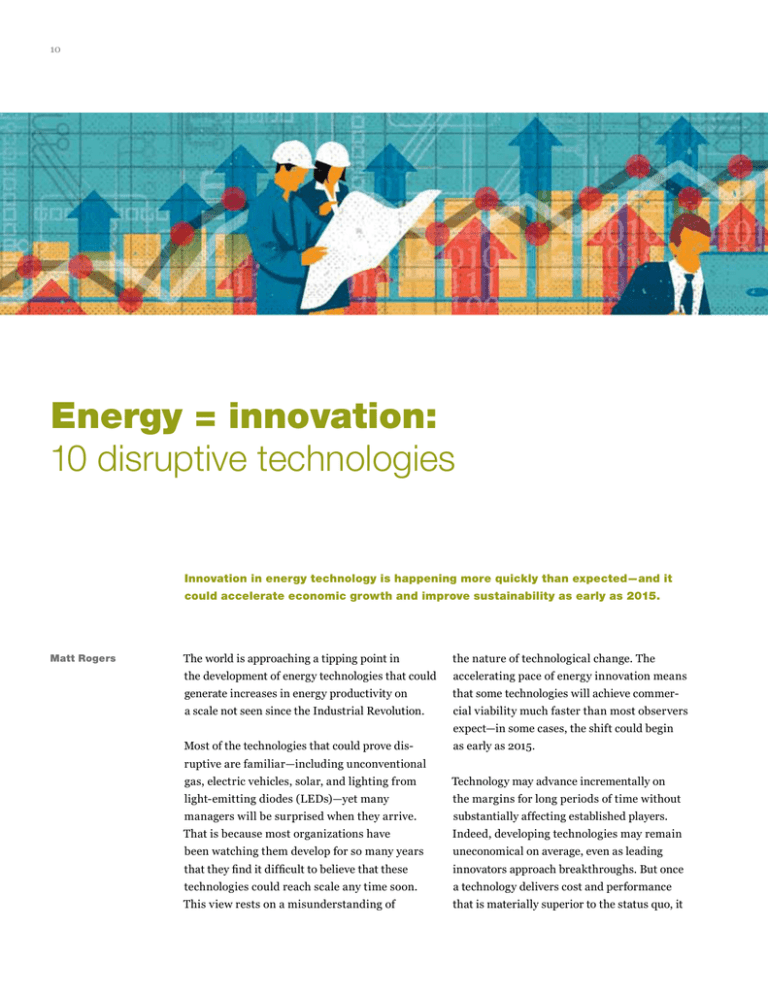
10
Energy = innovation:
10 disruptive technologies
Innovation in energy technology is happening more quickly than expected—and it
could accelerate economic growth and improve sustainability as early as 2015.
Matt Rogers
The world is approaching a tipping point in
the nature of technological change. The
the development of energy technologies that could
accelerating pace of energy innovation means
generate increases in energy productivity on
that some technologies will achieve commer-
a scale not seen since the Industrial Revolution.
cial viability much faster than most observers
Most of the technologies that could prove dis-
as early as 2015.
expect—in some cases, the shift could begin
ruptive are familiar—including unconventional
gas, electric vehicles, solar, and lighting from
Technology may advance incrementally on
light-emitting diodes (LEDs)—yet many
the margins for long periods of time without
managers will be surprised when they arrive.
substantially affecting established players.
That is because most organizations have
Indeed, developing technologies may remain
been watching them develop for so many years
uneconomical on average, even as leading
that they find it difficult to believe that these
innovators approach breakthroughs. But once
technologies could reach scale any time soon.
a technology delivers cost and performance
This view rests on a misunderstanding of
that is materially superior to the status quo, it
11
may well be adopted en masse. Such technologies
2015: unconventional natural-gas production,
can render existing ways of doing business
electric vehicles, advanced internal-combustion
untenable in less than a decade—the blink of an
engines (ICE), solar, and LED lighting. Another
eye, in economic terms.
five could do so in the period shortly after 2020:
grid-scale storage, digital power conversion,
History shows that innovations in technology can
compressor-less air-conditioning and electro-
cause dramatic increases in productivity, trans-
chromic windows, clean coal, and biofuels
forming industries and setting whole societies on
and electrofuels. These technologies have broad
new paths to growth. For example, the rise of
applications, and they are mature enough
wireless technology fundamentally altered tele-
to disrupt markets when their implementation
communications. PCs and smartphones,
costs drop below those of the technologies that
enabled by ever-smaller and faster chips, have
currently dominate their industries.
revolutionized the consumer-electronics
industry. And portable audio devices—starting
The widespread adoption of any of these tech-
with the Sony Walkman and continuing with
nologies could save customers hundreds of
the iPod—have radically transformed the way
billions of dollars annually and help countries
music is packaged and consumed.
achieve economic growth without degrading
Energy markets are on the verge of a similarly
nologies achieve breakthroughs, the world
dramatic transformation. With prices for oil,
economy and the environment will benefit tremen-
steel, copper, aluminum, and other commodities
dously. These advances may also provide
soaring to historic highs, energy-technology
national-security benefits by reducing countries’
innovators are taking advantage of developments
reliance on fuel and other commodity imports.
the environment. Even if only a few of the tech-
in areas such as software and consumer electronics, semiconductors, and pharmaceuticals
While it is impossible to predict which of these
to greatly improve how the world produces
technologies will thrive and to what degree, it is
and consumes energy.
clear that some will. For many companies,
The pace of change could be unprecedented.
this “uncertain inevitability.” A breakthrough
To succeed, companies must understand the
in any of these technologies could mark the point
major performance thresholds for each technology
of no return for an incumbent that is not prepared
survival will depend on the ability to navigate
and the market shifts that breakthroughs will
for it. As such, every company should take steps
trigger. Those that are content merely to keep an
to ensure it is positioned to benefit if the following
eye on technological developments, betting
breakthrough scenarios come to pass.
on averages rather than positioning themselves to
benefit from the cutting edge, may fail to survive
Market impact could begin as early
in the new world these innovations create.
as 2015
Technologies that have rapidly declining cost
In the United States, five technologies have the
curves and that save consumers money are
potential to begin to affect energy productivity by
developing much faster than technologies that
12
McKinsey on Sustainability & Resource Productivity Summer 2012
rely on regulation to be economically viable. Each
The North American case is clear, and the tech-
of the five technologies in this section benefits
nology has the potential to reshape global
from software and consumer electronics to
resource economics and politics as Europe, China,
accelerate the rate of change, and each has six to
and India begin to evaluate and tap their
eight competing pathways that could deliver
unconventional natural-gas resources. While
breakthrough performance. Competition among
those harnessing the technology must address
countries introduces multiple forms of innovation
significant water and land-use challenges, it could
to the market in parallel; Chinese low-cost
still be the most important energy-technology
engineering, Korean manufacturing scale and
innovation of the last 100 years.
quality, German systems integration, and US
product innovation are all important factors, and
Electric vehicles. The cost of advanced batteries
the intense competition benefits consumers.
is dropping precipitously. In 2009, advanced
Competition among technologies (for example,
batteries cost about $1,000 per kilowatt hour.
solar versus wind versus natural gas and electric
New battery-manufacturing facilities were
vehicles versus advanced ICE versus fuel cells)
able to deliver batteries at just over $500 per
raises the bar and often accelerates innovation.
kilowatt hour in 2010, and the price could drop
to $350 per kilowatt hour when these facilities
Unconventional gas. In the 1980s, massive
reach full-scale production over the next few
unconventional natural-gas resources
years. The cost of batteries could reach total-cost-
were identified in the United States, spurring
of-ownership parity with ICE when the price
advances in horizontal drilling, four-
drops to $250 per kilowatt hour, at which point
dimensional seismic imaging and software
the global market could increase to 15 million
modeling, and hydraulic fracturing (“fracking”)
to 20 million sold per year, from 1 million to
that enabled gas to be extracted from shale
2 million sold per year today. Of course, it could
formations. The technology was implemented at
take three to five years from the time batteries
scale for the first time in the early 2000s in
become cheap until automakers can integrate
response to significant tightening of supply in
these new designs into standard automotive
the US natural-gas market. Estimates of US
platforms, pushing back consumer-benefit time-
natural-gas reserves were increased by 50
lines. Nevertheless, once these vehicles are
percent within five years, and prices fell rapidly,
available on the market, the resulting improved
from more than $10 per thousand cubic feet
fuel economy could save consumers more
in 2008 to about $4 per thousand cubic feet in
than $500 billion annually in the near term,
2011 and just over $2 per thousand cubic feet
replacing high-cost, mostly imported oil
in 2012, as the market realized the new technol-
with lower-cost domestic electricity. Moreover,
ogies could deliver low-cost gas reliably for
customers are discovering that electric
decades. These new natural-gas supplies are
vehicles often deliver better acceleration,
already saving US consumers billions and
safety, and comfort and may be able to
enabling the country to reduce its emissions
support new vehicle-design innovations better
of greenhouse gases.
than traditional technologies.
Energy = innovation: 10 disruptive technologies
13
Advanced ICE. US corporate average fuel
providing an alternative to traditional
economy (CAFE) standards remained flat for
power sources.
nearly three decades, at 27.5 miles per gallon,
while vehicle technology continued to improve.
LED lighting. Lighting accounts for almost
New CAFE standards will require automakers
15 percent of US electricity demand. LEDs, which
to achieve 35.5 miles per gallon in 2016 and 54.5
rely on semiconductors, benefit from rates of
miles per gallon in 2025. Even then, US stan-
improvement dictated by Moore’s Law. Software
dards will remain below the European and Chinese
increases the value in LEDs by adjusting
standards that define automotive requirements
their energy use based on needed lighting levels.
in the rest of the world. Consumers are demanding
A 100-lumen LED bulb cost $20 in 2011,
vehicles that are more fuel efficient, and the
down from $50 in 2009. The price should drop
material science and software controls are now in
to between $8 and $10 for a 170-lumen bulb
place to deliver them. Consumers stand to save
by 2015, which would render incandescent and
almost as much from improvements made to the
compact-fluorescent bulbs obsolete. LED lighting
internal-combustion engine as they do from
currently accounts for approximately 2 percent
breakthroughs in electric vehicles—the compe-
of the global lighting market, but it could represent
tition among technologies is likely to create
30 percent by 2015 and 80 percent by 2020. If
more attractive high-efficiency, low-cost alter-
LED lighting reaches these levels, global consumers
natives for consumers.
could save more than $50 billion annually by
Solar photovoltaics (PV). The installed cost of
which could enable a 1.5 percent decline in US
2015 and more than $100 billion annually by 2020,
solar power has fallen to about $2.50 per
electricity demand per year, the equivalent of more
watt in 2012, down from $4 per watt in 2011,
than 30 base-load power plants.
and from about $7 to $8 per watt as recently as
2009. The US solar market grew by about 40
Market impact after 2020
percent due to the US stimulus program in 2009
Scientific and engineering innovations will be
and 2010, mirroring the global rate of growth
required for a subsequent wave of energy
driven by similar incentives provided in
technologies to reach commercial scale at viable
Germany, Italy, Spain, and China. Subsidies are
costs. These technologies will also likely
likely to dry up, but the momentum could
depend on regulations to expand available markets.
continue, supported by significant innovations
Not all of these technologies will succeed in
in manufacturing scale, quality yield, and
the market—they will only earn a place if they can
“balance of system” costs, potentially driving
outdo top performers from the earlier wave.
solar prices down to $1.50 per watt by 2015
If successful, however, these technologies could
and to less than $1 per watt by 2020. At these
render some of the earlier innovations obsolete.
prices, solar PV will be preferable to retail
electric prices for most new homes and big-box
Grid-scale storage. A variety of technologies,
commercial businesses in sunny markets,
including batteries, flywheels, and ultracapacitors,
14
McKinsey on Sustainability & Resource Productivity Summer 2012
are being developed to enable large-scale storage
conventional technology at less than one-tenth
of electricity within electric power grids, many of
the cost by 2020. China is particularly well
which are following an innovation pattern similar
positioned to benefit from adopting digital power
to auto batteries. Today, grid storage costs about
electronics due to the scale of grid expansion it
$600 to $1,000 per kilowatt hour and can be
has planned.
used only when local geology supports pumped
hydro or compressed-air storage systems.
Compressor-less air-conditioning and
Innovations that make use of flow batteries, liquid-
electrochromic windows. Today, it costs about
metal batteries, and other technologies could
$3,000 to $4,000 per year to run a high-efficiency
reduce costs to between $150 and $200 per kilo-
air conditioner in a hot region, and the efficient
watt hour by 2020 and make it possible to
windows now in common use allow 50 percent of
provide grid storage in every major metropolitan
this cooling energy to escape. New compressor-
market. At these prices, the United States alone
less air conditioners and electrochromic window
would want to build more than 100 gigawatts of
technologies offer the potential to cut home
storage over a decade (the capacity equivalent
heating and cooling bills in half. Today, these
of the current US nuclear generation fleet), signifi-
technologies are expensive, but by 2020,
cantly improving reliability and making solar,
they could begin to cost only about half as much
wind, nuclear, and coal much cheaper to deliver.
to install as current state-of-the-art cooling
Power companies can also use storage to
and window technologies.
smooth variability in power supply, which is more
extreme for renewable technologies than
Clean coal. Carbon capture and sequestration
for traditional generation technologies; doing
currently costs $8,000 to $10,000 per kilowatt.
so would significantly reduce distribution
Innovative processes now under develop-
capital requirements.
ment could help coal-fired generators in the
United States capture more than 90 percent
Digital power conversion. Edison and
of their carbon dioxide, enabling them
Westinghouse invented large-scale, high-voltage
to meet stringent new Environmental Protection
transformers in 1885, setting the stage for
Agency pollution-control requirements.
widespread development of the electrical grid.
Generators should be able to retrofit their
The technology in use today remains virtually
existing plants with new clean-coal tech-
unchanged. A typical transformer costs $20,000,
nology for less than $2,000 per kilowatt. About
weighs 10,000 pounds, and takes up 250 cubic
200 US coal plants are currently slated for
feet. High-speed, very reliable digital switches
closure by 2020 due to their high cost relative
made of silicon carbide and gallium nitride have
to natural gas and their pollution output.
been developed for high-frequency power
New clean-coal technologies could enable many
management in military contexts. They use
of these plants and similar plants in Europe
90 percent less energy, take up only about
and China to remain open for decades. However,
1 percent as much space, and are more reliable
clean-coal technologies are unlikely to be
and flexible than existing transformers. These
deployed at scale unless supportive carbon
digital transformers could begin to replace
regulations are put in place.
Energy = innovation: 10 disruptive technologies
15
Biofuels and electrofuels. With crude-oil prices
Not every technology we have discussed will come
reaching $100 per barrel, biofuels such as cane
to fruition, but some will—and those that do will
and corn ethanol have already rapidly increased
change energy markets dramatically and for good.
their market share. But the supply of biofuels is
Companies must understand cutting-edge
limited by demand for food and the declining
technology if they want to succeed in the energy
quality of available land, which drives costs up
markets of the future. In particular, they must
and minimizes the potential for growth. Genetic
develop the ability to understand the technology
innovations that enable the use of cellulosic
road maps coming out of the software and
and algae-based biofuels can free producers from
consumer-electronics sectors and track inno-
these constraints. The most innovative start-
vators in key markets. They must know what
ups in this area are creating high-margin specialty
particular countries are doing in their areas of
chemicals and blend stocks, generating cash
competitive advantage, including understanding
now and providing a pathway to begin to deliver
balance-of-system costs in China, consumer
biofuels at $2 per gallon or less by 2020. At the
electronics in Japan and Korea, and the impact
same time, biopharmaceutical researchers are
of software on product economics in Germany
developing electrofuels pathways that feed carbon
and the United States. Finally, companies must be
dioxide, water, and energy to enzymes to create
aware of the price and performance thresholds
long-chain carbon molecules that function like
that will trigger massive shifts in demand for each
fossil fuels at one-tenth the cost of current
relevant technology. Those that neglect what is
biofuels. The key question is whether these new
happening on the margins today put themselves at
technologies can scale.
risk of being pushed to the margins themselves in
the not-too-distant future.
Matt Rogers is a director in McKinsey’s San Francisco office. Copyright © 2012 McKinsey & Company.
All rights reserved.


